Orinoco
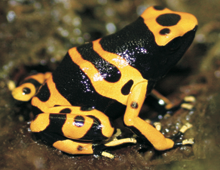
Yellow-banded dart frog, Dendrobates leucomelas
Since “leucomelas” means “white and black” in Greek, it is likely this scientific name was assigned on the basis of colorless museum specimens, preserved in alcohol. In life, these frogs are bright orange-yellow, with black bands or stripes. Like other dart frogs, wild ones, which are poisonous, but captive animals kept on a diet of fruit flies and crickets largely lose their toxicity. This species comes from Venezuela and adjoining areas of Northern South America.
LEARN MORE
Red howler monkey, Alouatta seniculus
At times, the DWA troop of Red howler monkeys, unique in North America, are heard long before they are seen. The mechanical-sounding, rumbling growl is produced by an enormous larynx (voice box) and can be heard three miles away. The only animal sound that is louder is made by Blue whales. The howlers are often next to the ceiling of their high enclosure. While this South American primate was notorious for being difficult to keep in zoos, it has done well at the DWA, where a number have been born and raised.
LEARN MORE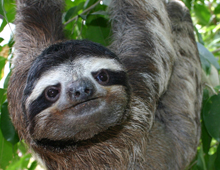
Brown-throated three-toed sloth, Bradypus variegatus
Almost all mammals have seven cervical vertebrae (the bones in the neck); manatees have six, two-toed sloths have five and three-toed sloths have nine. They also have no gall-bladder nor appendix, and cannot regulate their body temperature. Their teeth all look like molars, with no incisors. Throughout their Central and South American range, they live entirely upon leaves. Because the DWA provides a constant supply of Cecropia leaves, our male, “Leno”, has thrived here since 2005, setting the captive age record outside of Tropical America.
LEARN MORE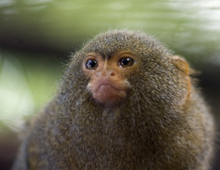
Pygmy marmoset, Callithrix pygmaea
The smallest New World primate, also the smallest monkey, weighs less than five ounces (the only smaller primates are several Madagascan lemurs). Pygmy marmosets occupy a rather large range in the forests of Western South America. Formerly rather rare in zoos, its captive population is now well managed with more than 700 world-wide, mostly captive-bred. It is usual for twins to be born. Despite their tiny size, they can live 20 years in captivity. In the wild, they specialize in eating gummy sap. In captivity, they do quite well on the same diets that larger marmosets and tamarins receive: a manufactured primate diet, fresh fruits and vegetables, and insects.
LEARN MORE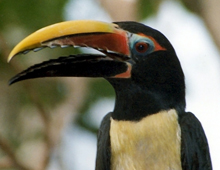
Green aracari, Pteroglossus viridis
Before the 1980s, this small toucan from Northeastern South America was very rare in captivity. Since the first captive breeding took place in 1980, in a California private aviary, hundreds have been hatched in the US, and the captive population appears to be self-sustaining. Those in zoos are carefully monitored for genetic diversity through a Species Survival Plan (SSP) of the Association of Zoos and Aquariums (AZA), and many others are kept privately. Since 2001, more than 50 have hatched at the DWA. This is one of the few toucans whose sexes can be easily distinguished; males have black heads and the females have brown heads.
LEARN MORE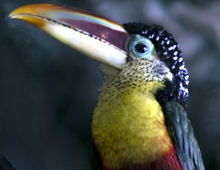
Curl-crested aracari, Pteroglossus beauharnaesii
This elegant bird is unique among toucans for having a cap of tightly curled feathers that appear “permed”. While not a rare bird in its range (south of the Amazon, divided among Peru, Bolivia, and Amazonian Brazil), it was almost unknown in captivity before the 1960s, and has never been common in zoos. The Curl-crested aracari was not bred in captivity until 1996. The DWA has had immense success propagating this species, with more than 100 birds since 2006.
LEARN MORE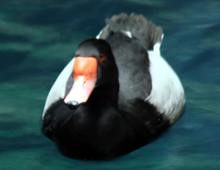
Rosy-billed pochard, Netta peposaca
This brightly-colored South American relative of the Canvasback, Redhead, and Scaups is another widely kept zoo duck that thrives in captivity. In contrast to the purplish-black and gray-pinstriped male, the female is mostly brown and lacks a knob on its beak, which is black instead of red.
LEARN MORE
Black-necked swan, Cygnus melanocoryphus
This magnificent bird was first bred in captivity, in Europe, more than 160 years ago, and his been highly prized in zoos and important private collections ever since. Found in southern South America and the Falkland Islands, it occurs in both fresh and salt water. Breeding pairs are devoted parents and carry their growing young on their back, almost sinking under their weight.
LEARN MORE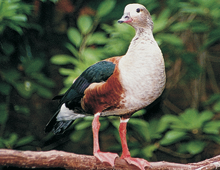
Orinoco goose, Neochen jubata
Not closely related to North American geese, this is an inhabitant of jungle rivers. Though it occupies a large range in northern South America, it is classified as Near Threatened. Despite a reputation for not tasting very good, it is still hunted, but deforestation is a greater threat since it nests in trees in the wild. It is found in only a few of the world’s zoos, but several have made a commitment to breeding it. During their noisy territorial defense displays, they assume such an upright position that it looks as if they might fall over backwards.
LEARN MORE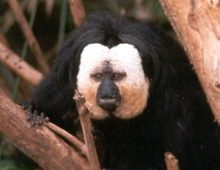
White-faced saki, Pithecia pithecia
Before the 1970s, this Northern South American monkey was very rare in captivity, but an improved understanding of its diet and health have led to this species being bred frequently, so that it is now one of the most widely-kept New World primates in American zoos. This is one of a relatively small number of primates where the sexes are easily told by their color; males are black with white faces, while females are grayish with a whitish line on either side of the muzzle.
LEARN MORE

